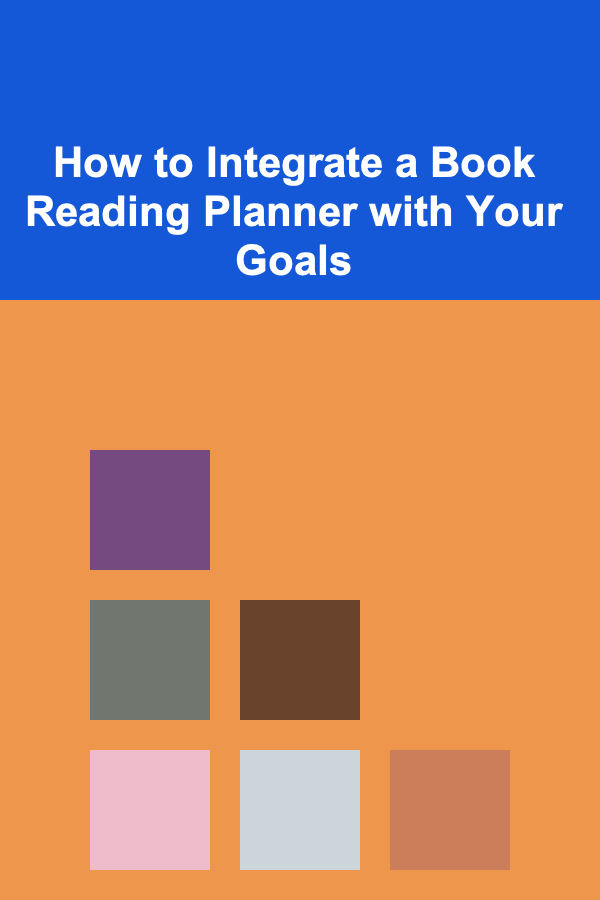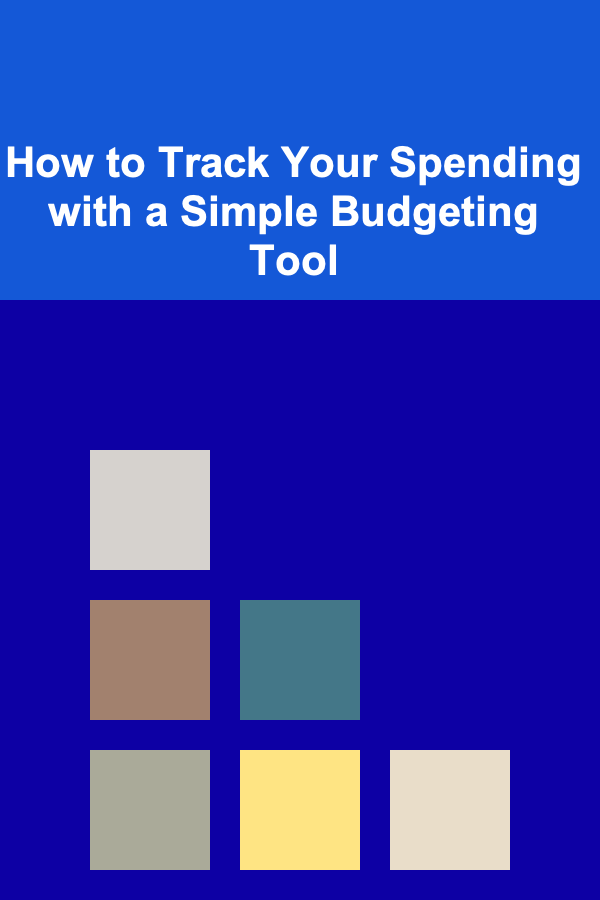
How to Integrate a Book Reading Planner with Your Goals
ebook include PDF & Audio bundle (Micro Guide)
$12.99$5.99
Limited Time Offer! Order within the next:

Reading books is a powerful way to acquire knowledge, expand your worldview, and foster personal growth. Whether for leisure, self-improvement, or career development, setting aside time for reading can have immense benefits. However, amidst the hustle and bustle of daily life, it can often be challenging to stay consistent and motivated. That's where a Book Reading Planner comes into play.
Integrating a book reading planner into your broader life goals can provide structure, increase accountability, and enhance your reading experience. This article will guide you on how to effectively integrate a book reading planner with your personal, professional, or academic goals to maximize its impact.
Understanding the Role of a Book Reading Planner
A book reading planner is a tool designed to help you organize and track your reading goals, maintain consistency, and stay on top of your reading habits. It's not just about choosing books to read; it's about aligning your reading habits with your overarching objectives---whether those are personal growth, career development, education, or leisure.
Benefits of Using a Book Reading Planner
- Structure: A planner helps organize your reading time, book choices, and progress, turning reading into a goal-oriented habit.
- Consistency: By setting clear goals and tracking progress, you can ensure that reading becomes a regular part of your routine.
- Accountability: A planner can hold you accountable, helping you stay motivated by providing tangible milestones to reach.
- Personal Growth: With a planner, you can ensure that you're selecting books that align with your personal development goals, whether in terms of skills, knowledge, or inspiration.
Assessing Your Goals and Identifying Reading Objectives
Before diving into setting up a book reading planner, the first step is to clearly identify your goals. Understanding why you want to read in the first place will allow you to choose books that serve a specific purpose. Your goals might vary across several areas:
Personal Development Goals
- Self-Improvement: If you're interested in personal growth, your books might focus on habits, mental health, motivation, or emotional intelligence.
- Health & Wellness: You might want to read books related to physical health, nutrition, mindfulness, and stress management.
- Creativity: Reading books related to art, writing, or other creative pursuits can help you unlock new ideas and approaches to your work.
Career Goals
- Skill Development: You can select books that align with the skills you need to develop for your job or future career aspirations, such as leadership, communication, or technical skills.
- Industry Knowledge: Stay updated with industry trends by reading books that expand your expertise in your professional field.
- Networking: Reading books on entrepreneurship or professional networking might align with career growth goals.
Academic or Educational Goals
- Textbooks and Research: For students or lifelong learners, reading might revolve around textbooks or academic materials that support your formal education or personal learning projects.
- Literature and History: For those interested in humanities or social sciences, you may choose books that expand your understanding of different cultures, histories, and ideas.
Leisure and Enjoyment
- Escapism: If you are looking to unwind and escape from your daily routine, reading fiction or fantasy novels can offer a relaxing escape.
- Cultural Exploration: Exploring books that expand your understanding of different cultures, genres, and languages can enhance your global perspective.
Setting Clear Reading Goals
Once you've assessed your goals, it's time to set concrete and measurable reading goals that align with those objectives. This involves identifying:
1. The Number of Books
Determine how many books you want to read in a given time frame---be it monthly, quarterly, or annually. This goal can be as ambitious or realistic as fits your schedule.
2. Time Commitment
Decide how much time per day or week you are willing to dedicate to reading. Whether it's 15 minutes a day or an hour every weekend, making time for reading is a key element of success.
3. Genre or Topic Focus
Based on your overall goals, narrow down the genre or topic you want to focus on. You could commit to reading a certain number of books in a specific genre, like self-help, biography, or fiction, or focus on a particular topic, like history or business strategy.
4. Tracking Progress
Using your reading planner, set milestones or checkpoints for tracking your progress. You can track chapters completed, time spent reading, or pages read per day. Setting these micro-goals will allow you to evaluate how effectively you're meeting your objectives.
5. Challenges and Adjustments
Life happens, and you might fall behind. Having a tracker in your reading planner allows you to adjust goals as needed. Whether it's adjusting your pace or prioritizing a different book, a flexible reading planner helps you stay on track despite unexpected challenges.
Choosing the Right Books for Your Goals
A critical part of creating a reading planner is selecting the right books that will help you achieve your goals. Here's how to choose wisely:
1. Align Books with Personal and Professional Objectives
For instance, if you're aiming to develop leadership skills, you might choose books on management, negotiation, and emotional intelligence. If your focus is on improving your physical health, reading about nutrition and fitness would be more beneficial.
2. Use Book Lists and Recommendations
Utilize curated lists from reputable sources such as Goodreads, academic journals, or professional organizations. Many well-known influencers, educators, and industry experts share their recommended readings in blog posts, podcasts, or video content.
3. Prioritize High-Impact Books
Books that are widely considered to have a high impact in your field, or that address key challenges you are facing, should be given priority. Don't just read for quantity---quality matters when it comes to achieving your long-term goals.
4. Diversify Your Reading
While focusing on specific goals, make sure to include a mix of genres to maintain variety in your reading habits. This can keep things interesting and avoid burnout.
Designing Your Book Reading Planner
Now that you have your goals and book list, it's time to set up your reading planner. Here are some tips for designing a functional and motivating planner:
1. Monthly and Weekly Overview
Break down your larger goals into smaller monthly and weekly targets. Create space to track the books you plan to read in the upcoming months, along with their key objectives.
2. Reading Schedule
Dedicate sections in your planner to mark the time you'll be reading each day. Having a fixed schedule will help you stay committed. Include notes on the best times for you to read---whether in the morning, during lunch, or before bed.
3. Book Details
For each book you plan to read, include fields for:
- Title and Author: Track the title and author of each book.
- Genre/Topic: Identify the genre or subject matter to ensure that it aligns with your personal or professional goals.
- Start and End Dates: Plan when you'll start and finish each book.
- Takeaways: Jot down key takeaways or insights from each book.
4. Reflection Section
Create space for reflections after each book. What did you learn? How will this book help you achieve your personal or professional goals? This will reinforce your commitment to your goals and give you a sense of accomplishment.
5. Visual Progress Tracker
Incorporate visual elements such as a progress bar or percentage tracker for each book or goal. This can serve as motivation, providing a clear view of how much progress you're making.
Tracking Your Progress
Once your planner is set up, tracking progress is vital. The act of crossing off a finished book or marking the completion of a milestone provides a sense of achievement and reinforces positive behavior.
1. Celebrate Milestones
Recognize your accomplishments as you hit milestones, such as finishing a book or reaching a certain number of pages or chapters. Reward yourself by sharing your achievements with others or indulging in something special like a coffee break or an afternoon off.
2. Review and Adjust
At regular intervals, take time to reflect on your progress and adjust your goals if necessary. Sometimes goals evolve, and your reading plan should be flexible enough to accommodate changes. Additionally, review your book list to see if it still aligns with your evolving goals.
3. Stay Accountable
You may choose to share your reading goals with a friend, colleague, or mentor, or participate in book clubs or reading groups. Sharing progress helps create a sense of accountability, making it more likely that you'll stick to your reading routine.
Conclusion
Integrating a book reading planner with your goals can transform your reading experience into a more structured, purposeful, and rewarding activity. By aligning your reading habits with your personal, professional, and academic goals, you can create a meaningful and sustainable approach to learning and self-improvement. Take the time to design a planner that works for you, set clear objectives, track your progress, and adapt as needed. The ultimate reward is not just finishing books but using the knowledge gained to enhance your life and move closer to achieving your goals.
Reading More From Our Other Websites
- [Hiking with Kids Tip 101] How to Choose the Perfect Daypack for Kids Who Carry Their Own Snacks
- [Horseback Riding Tip 101] Must‑Try Horse Riding Exercises for Building Core Strength
- [Horseback Riding Tip 101] Improving Balance on the Saddle: Targeted Drills for All Skill Levels
- [Home Maintenance 101] How to Maintain Your Home's Fence to Ensure Long-Term Durability
- [Biking 101] The Benefits of Spin Bikes for Cardiovascular Health
- [Home Cleaning 101] How to Clean Your Home When You Have Limited Time
- [Personal Care Tips 101] How to Apply Body Lotion for Better Skin Absorption
- [Home Budget Decorating 101] How to Create a Zen-Inspired Space in Your Home on a Budget
- [Home Security 101] How to Secure Your Shed or Outbuilding Against Intruders
- [Personal Finance Management 101] How to Celebrate Financial Milestones with Your Family

How to Choose the Right Size Furniture for Your Space
Read More
How to Track Your Spending with a Simple Budgeting Tool
Read More
How to Use YouTube to Make Money: A Deep Dive into the Business of Content Creation
Read More
The Art of Risk Management: Navigating Complex Risks in Today's Business Environment
Read More
How to Cook Comfort Food with a Healthy Twist
Read More
10 Tips for Hiking in Different Weather Conditions
Read MoreOther Products

How to Choose the Right Size Furniture for Your Space
Read More
How to Track Your Spending with a Simple Budgeting Tool
Read More
How to Use YouTube to Make Money: A Deep Dive into the Business of Content Creation
Read More
The Art of Risk Management: Navigating Complex Risks in Today's Business Environment
Read More
How to Cook Comfort Food with a Healthy Twist
Read More